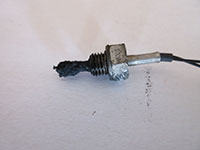The 6.6L Duramax diesel utilizes an intake air temperature (IAT) sensor incorporated into the mass airflow (MAF) sensor. However, LLY, LBZ, and LMM engine generations (2006 to 2010 model years) employ a second IAT sensor located in the intake manifold bridge beneath the turbocharger inlet mouthpiece. A diagnostic trouble code referencing IAT circuit 1 refers to the MAF sensor (P0113, for example), which is mounted inline with the intake tube near the air filter housing. A diagnostic trouble code referencing IAT circuit 2 refers to the dedicated IAT sensor located in the intake manifold bridge (P0098, for example).
Click any thumbnail to view fullsize, detailed image
• Disconnect both negative battery cables.
• Remove the intake tubing between the air cleaner housing and turbocharger mouthpiece.
• Remove the driver side inner fender.
• Remove the intake resonator.
• Remove the driver side intercooler tube to gain access to the driver side CCV hose.
• Follow the crankcase ventilation hose from the turbocharger mouthpiece to the valve covers on either bank of the engine. Remove the retaining bolt for the CCV flange at the valve cover housing using an 8 mm socket (1 bolt for each bank), then pull the hose out of the valve cover housing. Repeat for the opposite bank, the hose connects to both valve covers.
• Loosen the hose clamp where the CCV hose attaches to the turbocharger inlet mouthpiece, then remove the hose and set aside.
• The IAT sensor is located in the intake manifold crossover bridge in front of and below the turbocharger compressor inlet.
• Trace the IAT sensor wire and disconnect the electrical connector.
• Remove the IAT sensor using a 14 mm wrench or sensor socket. A flare nut wrench/flare nut crows foot is preferred as it reduces the risk of rounding the edges of the hex head.
• Install the new IAT sensor in reverse order, then reconnect the electrical connector.
• Clean all removed parts as necessary and replace the CCV hose o-rings.
• Reinstall the turbocharger mouthpiece, intake tubing, CCV hose, intercooler tube, etc in reverse order.
• Although the IAT sensor can become dirty from exposure to oil vapors and exhaust soot, failures are typically the result of an internal malfunction. Cleaning and reinstalling the IAT sensor rarely eliminates related DTCs in our experience, however it is an option for those hoping to circumvent replacement costs.







